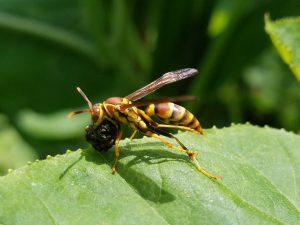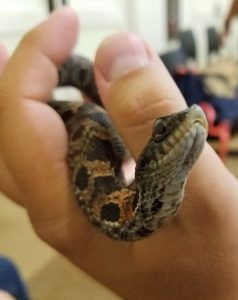Our recent storm was traumatic in a lot of ways, and not only for humans. Many animals found their homes destroyed by the weather, which may unfortunately make cleanup and recovery even more difficult for everybody. While cooler temperatures in the fall and winter seasons will keep a lot of creatures from being too active, it can also send those who lost their shelter looking for new places to hide. If you live in a storm affected area – and most of the Florida panhandle was, in one way or another – watch out for dangerous wildlife.

Paper wasps often build their nests overhead on the eaves of buildings or in trees. Watch out!
Insects that build nests, such as bees, yellowjackets, and wasps, may still be on the wing. When their nests are destroyed or disturbed, individuals who are displaced may be flying around, looking for food or shelter. New nests will undoubtedly be built in areas that may not have had any previously, and any source of food is bound to attract attention. Piles of debris are good places for insects such as these to seek shelter, so wear protective clothing and pay close attention while doing cleanup. A brush pile that stays in the same place for a week or more might gain some unwelcome tenants. Look for paper wasp nests on eaves or in plant material, yellowjacket burrows in the ground or in hollow trees or stumps, and hornets in trees. Remove potential sources of food such as garbage with sugary residues or tree debris with sweet sap. Don’t forget that any pets or livestock you own might be affected by insects as well, so keep a close eye on pastures and areas where pets reside for signs of new infestations of stinging insects. A simple homemade trap may help to keep wasps and yellowjackets under control (you can find more information on making traps: Do-It-Yourself Insect Pest Traps. If you find a nest and need to use insecticides to get rid of it, remember to read the label before using the product.

Some snakes are harmless, like this hognose rattlesnake. Similar looking snakes such as the pygmy rattlesnake might be dangerous to people and livestock.
Snakes are another potentially dangerous creature that may be displaced, and constant wet weather may have them residing in areas they wouldn’t otherwise consider. Anywhere that might offer some warmth in these cool months is particularly attractive to a cold-blooded creature, and damaged buildings or brush piles fit the bill perfectly. Rattlesnakes, copperheads, and cottonmouths are some of the more dangerous snakes we have around, but remember that not every species of snake is dangerous. For help in identifying snakes, consult our EDIS publications on this topic: Dealing with Snakes in Florida’s Residential Areas—Identifying Commonly Encountered Snakes, Recognizing Florida’s Venomous Snakes, and Native Snakes Easily Mistaken for Introduced Constrictors in Florida. Keep leaf piles, cut branches and trees, and other debris away from homes and areas where domesticated animals and pets live, if possible .
Remember that you can always contact your local Extension office for help in identifying and advice on controlling pests, whether they’re snakes or hornets, spiders or scorpions, or something even more exotic.
Evan Anderson, Walton County Agriculture Agent
- When Grasses Collide – Centipede vs. Bahiagrass in Your Pasture - August 26, 2022
- Time to Think About Pond Weeds - March 18, 2022
- Avoiding Pesticide Resistance - September 24, 2021
